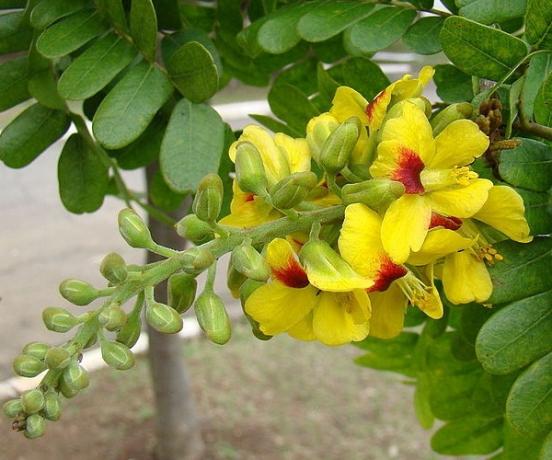The brazilwood (paubrasilia echinata) is tree originating in Brazil, which occurs in the Atlantic Forest zone, especially in the northeast region of Brazil. It can be found in the coastal zone of the country, from the state of Ceará to Rio de Janeiro.
It was the discovery of the existence of this species that gave rise to the name of the country, after the arrival of Portuguese navigators in Brazil. Initially the name given to the country was Terra Brasilis, being later modified to Brazil.

Characteristics of Brazilwood
The tree can reach 15 meters in height and can live for approximately 300 years. There are records that in the past, trees could reach 30 meters or more. However, due to exploitation and the decline of the species, this no longer happens.
It has wood in dark tones and with very specific characteristics: it is rigid, very resistant and heavy. For this reason it was very stratified for use in joinery.
THE resin of the tree has an intense reddish color. It is probably for this reason that the tree received the name pau-brasil, due to the origin of the word ember (
bersil), which refers to the earthy and reddish tones of its bark and resin.The brazilwood has flowers yellows, known for their striking scent. The tree blooms only once a year, between the months of September and October.
already the fruit it's green. It is very similar to a pod, but with thorns all along its length. After ripening, between November and January, it darkens, turns brown and releases the seeds.
 Redwood flower.
Redwood flower.
Other names
In addition to the best-known name, pau-brasil also receives other names:
- pau-de-pernambuco,
- paint stick,
- pink stick,
- red stick,
- Brazil tree,
- brazilian,
- ibirapita,
- ibirapiranga,
- ibirapitanga.
Exploration of brazilwood
The history of the exploration of the tree is mixed with the arrival of Portuguese navigators in Brazil, extending throughout the entire period of colonization. Brazilwood was the first form of exploration used by the Portuguese, being probably the first business and source of wealth for the Portuguese Crown in the country.
Two parts of the tree were used: a wood and resin. The wood, for its characteristic of resistance and durability, was used for the construction of luxurious furniture. The reddish colored resin was extracted and used as a dye for fabrics. The colorant made from brazilwood was called brasileína.
The use of resin as a dye was not a discovery of the Portuguese. When they arrived in Brazil, this process was already carried out by the Indians who inhabited the Brazilian lands, being, therefore, appropriated and exploited by the Portuguese. The use of resin as a dye only stopped happening in the 19th century, after the emergence of artificial dyes.
The exploration of pau-brasil was carried out, initially with the slave labor of the Indians who already lived in Brazilian lands. The use and exploitation of pau-brasil in this period was very intense, causing a considerable decrease in the number of trees. That's why the species became considered extinct.

Brazil wood: reddish and resistant.
Also read the meaning of Extractivism.
The brazilwood currently
Nowadays, brazilwood is not easily found. The specimens that still exist can be found in conservation areas of the species.
Currently, the wood from the tree is used for a specific purpose, which in no way resembles the initial exploration of the tree. Due to its durability, weight and resistance, it is used in the construction of violins, which can reach high selling prices. Countries like France and Germany and China are among the great importers of violins made with redwood wood.
Preservation of brazilwood
In 2012, the Ministry of the Environment created the Brazilwood National Conservation Program. The initiative was created to promote the creation of actions that guarantee the preservation of the species that gave rise to the country's name.
Among the activities that are part of the conservation program are: the identification of areas where the species still exists and the creation of measures that put into practice the National Action Plan of the Brazilwood.
national heritage
Due to its importance to the country's history, pau-brasil received the title of National Tree in 1978, through the publication of law nº 6607/78.
May 3rd was chosen as the commemorative date of Brazilwood Day, to remember the importance of preserving the tree.
